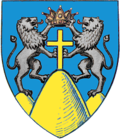Putna | |
|---|---|
 The medieval Putna monastery (as seen in the summer of 2000) | |
 Location in Suceava County | |
| Coordinates: 47°52′N25°37′E / 47.867°N 25.617°E | |
| Country | Romania |
| County | Suceava |
| Subdivisions | Putna, Gura Putnei |
| Government | |
| • Mayor (2024–2028) | Gheorghe Coroamă [1] (PNL) |
Area | 133.70 km2 (51.62 sq mi) |
| Elevation | 548 m (1,798 ft) |
| Population (2021-12-01) [2] | 3,658 |
| • Density | 27/km2 (71/sq mi) |
| Time zone | EET/EEST (UTC+2/+3) |
| Postal code | 727455 |
| Area code | (+40) x30 |
| Vehicle reg. | SV |
| Website | primariaputna |
Putna (German: Kloster-Putna) [3] is a commune in Suceava County, in the historical region of Bukovina, northeastern Romania. It is composed of two villages, namely Gura Putnei (German: Karlsberg) and Putna. The Putna Monastery, Putna River, and the cave of Daniil Sihastrul are located in this commune. It is also the starting point of the Via Transilvanica long-distance trail. [4]














